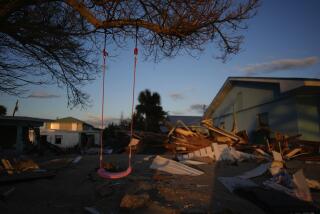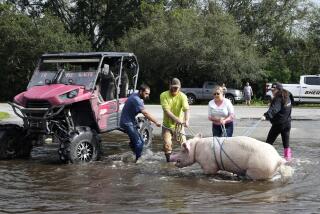Andrew Dealt a New Blow to the Fragile Everglades : Environment: Hurricane splintered trees and uprooted lives, but national park faces everyday threats.
HOMESTEAD, Fla. — In the Everglades, snails are reportedly mating with unusual fervor, new leaves are sprouting from ravaged gumbo limbo trees, the hearty alligator thrives as always and all 23 radio-collared endangered Florida panthers have been accounted for.
Yet more than six weeks after it was raked by some of the most powerful winds to strike the United States this century, no one knows for sure what lasting effect Hurricane Andrew has had on the national park that even before the storm was deemed the most critically ill of all federal preserves.
“The storm hasn’t killed Everglades National Park,” said Richard G. Ring, superintendent of the 1.5-million-acre park that occupies most of the Florida peninsula’s southern tip. “But it has added another level of stress.”
The cost of cleaning up, rebuilding and rewiring the park for electricity--with underground cables this time--is estimated at more than $50 million.
Under siege from pollution, development, exotic plants and fluctuating water levels, the Everglades is about to undergo an experimental eight-year, multimillion-dollar replumbing job designed to save it. However, work on the first phase--construction of two dams northeast of the Shark River Slough--has been delayed at least three months because of the storm, according to Lewis Hornung, project manager for the U.S. Army Corps of Engineers.
Not only have more than 600 Corps employees been sent to South Florida to help with debris removal and rebuilding, but “lots of key players have been personally devastated by the storm,” said Hornung. “They have to get their lives back in order first.”
Meanwhile, the park is closed to everyone except boaters, who can enter through Everglades City at the southernmost boundary, and is not expected to reopen until December. Even then, added Ring, “it will be several years before we are back to normal.”
Some of the hurricane’s effects are readily apparent. The main visitor center just five miles west of Homestead is missing much of its roof. Nature centers, offices and toll booths have been trashed by the wind, and wooden boardwalks, which once allowed tourists to hike out over the watery saw grass prairies, have been twisted and splintered. The park remains without electricity; regular telephone service has only recently been restored.
The eye of the powerful Aug. 24 storm passed right over the Everglades, and winds, which may have exceeded 175 m.p.h., snapped 100-foot slash pines in half, uprooted towering palms and mahogany trees and stripped the leaves off everything above 15 feet.
Park botanist Robert F. Doren estimates that throughout the park, from 18% to 50% of the trees are broken off or dead. Hardwood hammocks--jungle-like groves of trees and shrubs clinging to islands of high ground in the saw grass --have been hit even harder. “In the hammocks, the majority of the trees are down,” he said.
The hurricane also has uprooted the lives of park employees. More than 100 of 250 people employed by Everglades National Park, adjacent Biscayne National Park and Big Cypress National Preserve were left homeless by the storm, and a federal crisis intervention team has set up a program offering mental health counseling, which could run for years. “The hurricane passed through in hours,” said park spokeswoman Patricia Tolle. “But it’s going to take a long time to clean up the emotional damage.”
The homes of both Ring and Assistant Superintendent J. Durand Jones were destroyed. They and dozens of other park employees have been living with friends or staying in Flamingo Lodge, a collection of 100 cottages and motel rooms at the park’s southern boundary that is usually rented to tourists.
Damage to the delicate ecology of the Everglades, the “River of Grass” that is the source of fresh water for about 4 million South Florida residents, is tougher to gauge. Teams of scientists from all over the United States have arrived to assess harm to flora and fauna.
Preliminary evidence suggests that most animals did just fine in Hurricane Andrew, although some heron rookeries were ravaged and alligator nests and eggs destroyed.
In areas of the park, which at this time of year are normally awash with tourists--many of them European, only the songs of birds and the splash of an alligator as it makes a meal of a fish can be heard.
American coots, anhingas, herons and roseate spoonbills are plentiful. Palm warblers flit through the tattered branches of the hardwoods. Turtles bask in the sun atop fallen trees, and overhead turkey vultures and ospreys ride the updrafts with instinctual ease.
“Storms are a natural occurrence. These things exist in the natural world, and animals can handle them,” said Doren. What is less certain is the capability of the park--”disturbed and vulnerable,” in Doren’s words--to handle renewed attacks from exotic plant species that in recent years have posed one of the major threats to the wetlands.
The problems affecting the Everglades and its unique flora and fauna are not new. From the time Everglades National Park was created in 1947, the delicate balance of life in this fragile ecosystem has rested on the subtle cycles of water. But as development has pushed westward from Miami, wetlands have been drained and natural water cycles disrupted. The release of water to suit the needs of people in Miami has not always suited nesting birds and alligators.
Phosphorous from fertilizer and other nutrient runoffs from cattle ranches around Lake Okeechobee seep into the water as it flows south in a thin sheet to Florida Bay. Mercury contamination has been found in fish and mammals. Exotic trees such as melaleuca and casuarina (Australian pine) have spread exponentially, crowding out native species and destroying natural wildlife habitats.
In 1988, the U.S. Justice Department sued Florida, charging that the state’s failure to enforce its own water pollution laws had caused harm to federal property. The suit was settled last year with a plan to restore the natural flow of water to the Everglades while creating a 32,000-acre filtering marsh to screen pollutants.
In April, the Corps of Engineers weighed in with its plan, which has been under study for eight years and is expected to cost $81 million, to build spillways and remove levees to restore a deeper, more natural flow of water through the Shark River Slough, the central channel within the river of grass.
Ultimately, experts say, the park will bounce back from the hurricane, as it has for millennia, and belatedly, the restoration project will get under way. “I’m an optimist. Hey, the Glades grew up under these conditions. Storms are a natural part of nature here,” said Pete Rhoads, director of Everglades restoration for the South Florida Water Management District, which operates an 1,800-mile network of flood-control canals from Lake Okeechobee to Miami.
“But I am concerned that the Glades of today is not the same Glades we had 50 to 100 years ago. Its resiliency has been impaired.”
Environmentalist Joe Podgor of Friends of the Everglades said the storm may have abetted the melaleuca tree, a fast-growing opportunist that has spread across about 400,000 acres in the wetlands. Although officials have been waging a vigorous campaign to keep the melaleuca outside park borders, the destruction of native species and the melaleuca’s prodigious reproduction rate--one tree can generate 1,000 descendants in 18 months--have increased its threat, Podgor said.
Not only may Andrew’s winds have widely dispersed the melaleuca’s seeds, but the destruction of the high tree canopy permits more sunlight, which could further stimulate growth, Podgor added.
Outside the national park, which takes in only about half of the Everglades ecosystem, other naturalists are weighing the storm’s effects on coastal mangrove barriers and underwater reefs. In a 20- to 25-mile swath of Biscayne Bay shoreline, up to 80% of the largest red and black mangrove trees have been “extensively damaged,” according to Susan Markley, chief biologist for Dade County’s Department of Environmental Resource Management.
“Those trees cannot regenerate large trunks and limbs,” said Markley. “That ecosystem can only recover through the growth of younger plants or new seedings. It will be 10 to 20 years.”
The effects of the tree loss on fish and crustaceans, which feed on the decomposing leaves that fall into the water, and birds such as ibises, herons and cormorants, which nest or roost in the high branches, is not known. Markley suspects wildlife populations may be displaced, if not diminished.
A further consequence of the mangrove damage is the loss of a buffer against future storms. With their spidery root systems, mangroves serve to protect the coastline from erosion that would normally result from a 17-foot storm surge such as the one Andrew kicked up. That ability, said Markley, is now impaired.
Offshore, meadows of sea grass show no evidence of damage, while reefs seem minimally scarred by scouring and wave action, Markley said.
On the national park’s northern boundary, along the Tamiami Trail, about 350 Miccosukee Indians are also struggling to recover from the hurricane, a storm they have been expecting all their lives. “Our elders tell us about hurricanes from the time we are born,” said Theresa Osceola, 31. “We see it as something sent to purify and cleanse our land.”
Nonetheless, many chickees--thatched straw huts--were destroyed, and cement-block houses damaged. The tribe’s huge bingo hall remains closed and tourists, the chief source of tribal income, are only beginning to return.
“We will recover slowly,” said Jasper Nelson, assistant chairman of the Miccosukee tribe. “There is not that much talk about it. We just figure it happened. It’s nature.”
A Direct Hit
The storm hit the Everglades National Park head-on, its 175 m.p.h. winds snapping 100-foot pines in half, uprooting towering palms and stripping the leaves from everything above 15 feet. How the Everglades should work: The Everglades is an inches-deep river flowing, almost imperceptibly, south and southwest from Lake Okeechobee to Florida Bay and the Gulf of Mexico. A crippled system: The Everglades was in distress long before the hurricane hit. Some 30% of the Everglades has been drained for agriculture and development. Fresh water that once entered the aquifer and supplied coastal cities is drained away to the sea in canals, and salt water intrusion has become a serious problem. The effect on humans: South Florida’s water supply lies beneath the Everglades, collecting in ancient rock that acts like a giant cistern. Scientists believe that without the Everglades, this reservoir would become full of saltwater and southern Florida as we know it would be no more. Sources: “The Everglades Today,” George X. Sand; Encyclopedia Americana
More to Read
Sign up for Essential California
The most important California stories and recommendations in your inbox every morning.
You may occasionally receive promotional content from the Los Angeles Times.










